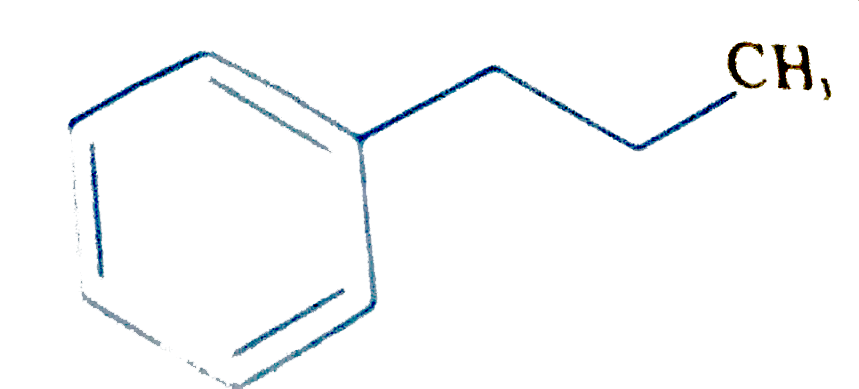Starting from benzene, how would you synthesize m - Bromonitrobenzene.
To synthesize m-Bromonitrobenzene starting from benzene, we can follow these steps:
Step 1: Nitration of Benzene
1. React benzene with a nitrating mixture: We will use a mixture of concentrated nitric acid (HNO3) and concentrated sulfuric acid (H2SO4). This mixture generates the nitronium ion (NO2+), which is the active nitrating species.
2. Reaction: The benzene ring will undergo electrophilic substitution, where the nitronium ion attacks the benzene, resulting in the formation of nitrobenzene.
C6H6+HNO3H2SO4−−−−→C6H5NO2+H2O
Step 2: Bromination of Nitrobenzene
1. React nitrobenzene with bromine: Now, we will take nitrobenzene and react it with bromine (Br2) in the presence of a non-polar solvent like carbon tetrachloride (CCl4). This will facilitate the bromination reaction.
2. Determine the position of bromine substitution: The nitro group (NO2) is a meta-directing group, meaning it directs the incoming electrophile (Br+) to the meta position relative to itself.
3. Reaction: The bromine will substitute at the meta position of the nitro group, resulting in the formation of m-Bromonitrobenzene.
C6H5NO2+Br2CCl4−−−→m-C6H4BrNO2+HBr
Final Product
- The final product obtained from these reactions is m-Bromonitrobenzene.
---
1. React benzene with a nitrating mixture: We will use a mixture of concentrated nitric acid (HNO3) and concentrated sulfuric acid (H2SO4). This mixture generates the nitronium ion (NO2+), which is the active nitrating species.
2. Reaction: The benzene ring will undergo electrophilic substitution, where the nitronium ion attacks the benzene, resulting in the formation of nitrobenzene.
C6H6+HNO3H2SO4−−−−→C6H5NO2+H2O
1. React nitrobenzene with bromine: Now, we will take nitrobenzene and react it with bromine (Br2) in the presence of a non-polar solvent like carbon tetrachloride (CCl4). This will facilitate the bromination reaction.
2. Determine the position of bromine substitution: The nitro group (NO2) is a meta-directing group, meaning it directs the incoming electrophile (Br+) to the meta position relative to itself.
3. Reaction: The bromine will substitute at the meta position of the nitro group, resulting in the formation of m-Bromonitrobenzene.
C6H5NO2+Br2CCl4−−−→m-C6H4BrNO2+HBr
- The final product obtained from these reactions is m-Bromonitrobenzene.
Topper's Solved these Questions
- HYDROCARBONSBOOK - CBSE COMPLEMENTARY MATERIALCHAPTER - HYDROCARBONSEXERCISE - 2- MARK QUESTION
28 Videos
- HYDROCARBONSBOOK - CBSE COMPLEMENTARY MATERIALCHAPTER - HYDROCARBONSEXERCISE - 3- MARK QUESTION
17 Videos
- HYDROCARBONSBOOK - CBSE COMPLEMENTARY MATERIALCHAPTER - HYDROCARBONSEXERCISE - ONE WORD TYPE QUESTION
10 Videos
- EQUILIBRIUM BOOK - CBSE COMPLEMENTARY MATERIALCHAPTER - EQUILIBRIUM EXERCISE - UNIT TEST
6 Videos
- HYDROGENBOOK - CBSE COMPLEMENTARY MATERIALCHAPTER - HYDROGENEXERCISE - Unit Test
11 Videos
Similar Questions
Knowledge Check
How can you synthesize nitric oxide in the laboratory?
AZinc with cold and dilute HNO3BZinc with concentracted HNO3CCopper with cold and dilute HNO3DHeating NH4NO3
How will you synthesize Alanine from acetylene?
View SolutionHow will you convert benzene into nitrobenzene?
View SolutionHow will you convert benzene into
m - Chloronitrobenzene ?
View SolutionStarting from borax, how would you obtain :
(a) Boric acid
(b) Boron trioxide
( c) Boron
(d) Bororn nitride
( e) Boron trichloride.
View SolutionHow will you convert benzoic acid into benzene ?
View SolutionHow would you separate propene from propyne ?
View SolutionHow will you convert ethanoic acid into benzene?
View Solution

 from benzene?
from benzene?